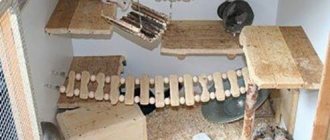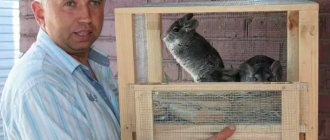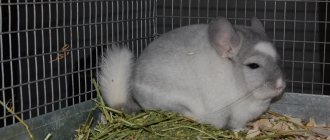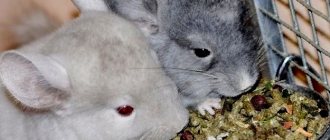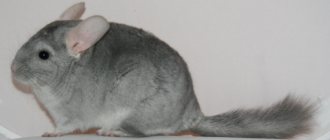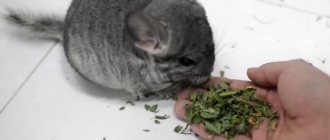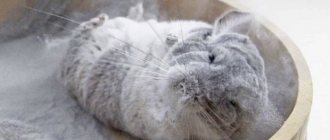If you decide to get a chinchilla as a pet, you should definitely think about where your pet will live. Of course, this place should be cozy and comfortable for the chinchilla, the health and life expectancy of the animal depends on this. A chinchilla cage is an issue that should be taken care of even before you get such a pet, so you need to understand all the intricacies of this topic.
Chinchillas
Chinchillas are animals that are listed in the Red Book! On many farms they are bred in order to later obtain valuable fur. These animals appeared in South America. They live in dry and rocky areas. Some of them can live up to twenty years.
Chinchillas feed mainly on plant foods and various insects. The activity of animals is highest at night. They began to be grown for valuable fur at the beginning of the 19th century. These animals can be kept both at home, as a pet, and on farms to obtain valuable fur.
The body of chinchillas reaches from 20 to 38 centimeters in length.
Pregnancy in chinchillas lasts 120 days, and then from one to six small animals can be born.
All these features need to be taken into account when choosing housing for pets.
You can have no more than two chinchillas in an apartment, but this will require a cage for them to live there. Knowing the size of the chinchilla cage, you can easily make it yourself! If your plans include the idea of having several animals, you will need a special enclosure. Here the question arises about what cage size for a chinchilla is minimal, optimal and ideal for farming.
Tools and materials
In making a chinchilla cage, you can use any available materials, including old cabinet furniture. The main thing is that it is not covered with paint or varnish on the inside of the enclosure. Also, it is necessary to check the workpieces for possible contamination by insects, fungus and mold. If the farm does not have suitable property, then it needs to be purchased. Pine boards and timber are best suited. This wood is light in weight, easy to saw and sand. As an option, it is allowed to use waterproof plywood or laminated chipboard.
The enclosure should be as light as possible and well ventilated. Therefore, it is worth making only one back wall, on which the filling of the chinchilla cage will be attached. If there is a need to close the room on one side from a draft, then this can be done using a sheet of plexiglass or monolithic polycarbonate.
It is advisable to cover the frame with steel mesh with a mesh size of no more than 2 cm. You should choose products with zinc coating or polymer coating. Such meshes resist corrosion better and look more elegant.
Tools required for work:
- roulette;
- level;
- hacksaw;
- screwdriver;
- square;
- hammer;
- metal scissors;
- paint brush;
- knife.
List of materials:
- sandpaper;
- antiseptic;
- self-tapping screws;
- glue;
- varnish;
- accessories (handles, hinges, rollers, corners);
- nails and screws.
It is recommended to take care of your own safety and work in protective gloves, goggles, and when applying paint and varnish solutions, in a respirator.
Breeding chinchillas for fur
It will no longer be possible to breed chinchillas for fur in a simple city apartment, because a whole family of rodents will not fit in one cage. They will need a specially equipped enclosure. On farms for these animals, enclosures are installed that do not block access for males to females, because if they do not meet, offspring will not appear. The dimensions of farm cages must be no less than 163 cm by 43 cm by 200 cm. To prevent females from leaving their cages to males, a special device is attached to their necks.
These cute creatures will live comfortably in places with temperatures of about 20 degrees. The animals are very sensitive to heat and less sensitive to cold. Make sure that the air temperature does not drop below zero!
Chinchillas will not live on metal bars, so place hay or sawdust on the bottom of the cage.
What to pay attention to
- Chinchillas are quiet animals and prefer to be nocturnal;
- they are easy to train, it is advisable to try to train them;
- care must be taken to keep their fur from getting wet. Rodents with such fur do not dry out completely, and the fur may become moldy over time;
- the chinchilla's cage should be in a quiet place so that nothing interrupts its sleep;
- this rodent is susceptible to stress;
- You should not feed your chinchilla human food;
- require children to handle animals carefully and, if possible, monitor this;
- remember the rodent's protective reaction to stress: hair loss, biting and splashing urine.
Breeding chinchillas as pets
As mentioned above, you can have chinchillas in an apartment or in a house. But it is worth remembering that it will not be possible to have more than two individuals. You will definitely need to purchase a cage for your unusual pets that will be comfortable and of a suitable size. 14-20 degrees Celsius will be the most suitable temperature for this type of rodent to live. Remember the most important thing: they absolutely cannot tolerate drafts or sunlight that falls directly on them.
Chinchillas that are bred at home very quickly get used to people and become completely tame. They will not be afraid of people. They will be very sweet, kind and friendly. But forget about the fact that they can be let out for a walk around the apartment. Rodents are natural chewers, so keep them in a cage. The size of the chinchilla cage must be chosen correctly to ensure the pet’s comfort.
How to clean a cage
The cage should be regularly cleaned, disinfected, and all accessories in it should be washed. Cleaning the animal's home should be done in the interests of itself. Prolonged presence in unsanitary conditions can lead to disease in the rodent. In addition, there is a specific smell that will begin to spread throughout the entire apartment if the animal’s home is not cleaned on time.
Cosmetic cleaning (pieces of food, wool) is carried out every day. This includes replacing sawdust with fresh ones, as well as washing the drinking bowl and feeder.
General cleaning of the cage is done once a week (at least). At the same time, all surfaces are disinfected and then thoroughly washed. Then the cell is dried for several more hours.
While the main cage is being cleaned, the animal is placed in a temporary one.
This article provides detailed recommendations on how to choose the right cage or display case for a chinchilla, how to equip it and where to place it. In good conditions, this rodent can live more than 20 years. Saving on a chinchilla cage and accessories is not advisable. In order not to return to the housing issue every year, it is better to immediately acquire a good quality cage or display case for your furry pet, or make it yourself.
Did you like the article? Share with friends: [supsystic-social-sharing id=”1"]
- Related Posts
- Chinchilla bathing in the sand
- Chinchilla feeder
- Chinchilla diet at home
« Previous entry
Choosing a cage for chinchillas
The size of the chinchilla cage should be such that the animal easily fits in there and can live comfortably.
Many experts say that cages are most suitable for this type of animal. But in order for rodents to feel comfortable there, you need to know what size a chinchilla’s cage should be. It's not that difficult to figure this out. So, what is the optimal cage size for chinchillas?
You choose a home for the animal. And you need to select the size of a cage for chinchillas according to the animal, and not according to your taste, because the main thing is that he feels cozy and comfortable in it. The animals spend most of their lives there, so don't skimp!
In addition to the question of what size a chinchilla cage is, you also need to ask yourself what should be inside it.
First, come to the store and choose a spacious, hygienic design. The passage to the cage must be simple. Do not leave chinchillas in places where there is constant noise or in isolated areas. The animals will not be able to relax, which means they will not be able to rest either. All this will not lead to good things.
Since the animals cannot stand the sun's rays, they cannot be placed near the window. Remember: if you want to sleep at night, do not put a cage with chinchillas in the bedroom, because their greatest peak of activity is at night.
Among the cages, the most popular are the ones with a retractable tray, as they are quite easy to care for.
So, the minimum cage size for a chinchilla is 50 cm by 70 cm by 50 cm. But this is still not enough. The optimal cage size for chinchillas is 84 cm by 50 cm by 40 cm.
Having purchased housing for animals, do not rush to place them there. First, add special shelves to the cage so that the animals can run somewhere. Place a food bowl and a drinking bowl. Some chinchilla owners make a house in their cages. If you have such a desire, then buy it, it won’t hurt.
Basic requirements for the premises
To make your chinchilla feel comfortable indoors, adhere to the basic requirements that apply to all types of cages. To ensure that the animal does not experience inconvenience, the room should be:
- light;
- warm;
- dry;
- comfortable;
- ventilated.
Zoologists recommend buying cages with parameters no less than these: height - 70 cm, length - 50 cm and width - 50 cm.
Warning! If possible, purchase a design larger than the minimum size. Because a chinchilla, oppressed by a small space, will often be exposed to various diseases. Therefore, you need to allocate areas for games and other entertainment.
For the safety of animals, buy cages with bars located close to each other, the distance of which should not exceed 2 cm. Because the animal can poke its head through and get stuck. Many chinchilla owners use a pull-out litter box. Because it is difficult to clean a firmly fixed floor. It's easier to pull out the tray and wash it. Also, bedding made of sawdust or hay should not lie for more than seven days. Replace bedding as often as possible.
Choosing a cage for chinchillas on a farm
If you will breed animals in order to later obtain valuable skins from them, then the size of a standard farm cage for chinchillas should be much larger than usual. There should be special tunnels through which the male can run to the females.
The cage should also have shelves that will be used by the animal for movement. A drinking bowl and food bowl must be present. You can also put up houses, but under no circumstances should they have a bottom!
The bottom of the cage can be covered with sawdust or straw, so the animal will be much more comfortable.
Form
In the store, customers will find a wide selection of cells of all possible shapes. Cylindrical, round models, decorated with original geometric elements - it is better to abandon all this. Such cages are inconvenient to clean and maintain, and the animal will feel uncomfortable in them. Remember these helpful tips to help you find the best home for your chinchilla:
- choose models of classic shapes: rectangular, or at least square;
- if the cage is larger in height than in width, the animal will happily climb up and down the floors;
- a good option is a cage on wheels, which can be moved to remove accumulated debris;
- Before purchasing, make sure the design is reliable and there are no sharp or traumatic elements.
Instructions for making a chinchilla cage at home with your own hands
So, before you start making the cage, you need to decide on the material. Plastic, chipboard or DVD will not work. Dirty wood infected with fungi is also not suitable. Artificial materials are also unsuitable for making cages for animals such as chinchillas. When making a cage, pay attention to various small items, such as bolts, nuts, and so on. They must be securely fastened. They are small in size, which means that animals can easily swallow them, which is very bad.
So, the cell itself, or rather its frame, is made of aluminum. The side walls are made of metal mesh, and the pallet is made of steel sheets. Other materials are used for finishing inside the cage.
Once the structure is ready, you can fill the bottom with sawdust or straw for the chinchilla’s comfort. They will have to be changed daily, but in parts, and every week - completely.
Popular cell types
Sand for chinchillas, composition, special attention is paid to it, since the beauty of the fur skin depends on it. The animals perform hygienic procedures in the sand, while the use of river sand, as well as quartz sand, is excluded
With sharp fragments, the material does not clean the fur, but spoils and cuts the hair.
You can check the quality of dust content in the package only after opening it; the color of the composition should be matte; any shine indicates foreign particles. If you rub them in your hands, there should be a trace left on them, like powder, when poured with liquid, the real dust will dissolve, and the heavy quartz will settle to the bottom of the container. Before arranging a swim, you need to resolve the issue of housing. Home cages are somewhat different from professional cages.
Chinchilla cage
The following designs were included in the review, the most popular among breeders:
- Houses connected with metal rods. Similar options are presented by sales representatives; they are easy to build yourself. The advantage of such buildings is their low cost and ease of installation.
- Manufacturers, in general, completely supply all the necessary parts; it will not be difficult for the owner to assemble the elements and not worry about further arrangement.
- The dwellings, presented as a kind of showcase, will be needed by a livestock breeder who has decided to start a family of chinchillas. In this constructive space there are all the details necessary for future offspring. The material chosen is different, but suitable both for interior decoration, where wood is preferred, and for external structures made of metal elements.
Chinchillas have become a profitable business because of their fur. For commercial breeding, cages of other sizes and designs are needed, designed for the constant reproduction of individuals.
We suggest you familiarize yourself with: DIY pig feeders
A male can serve up to 8 chinchillas, but the owner tries to keep a good sire and prefers to give him no more than 4 future mothers. The cells are arranged in cells arranged on floors, where each is intended for one family. The uteri are separated from each other by their own space, but the rodent moves freely between them through a special passage built into each combined cell wall.
Main rules for keeping chinchillas
You should know that chinchillas practically do not shed, and if they do, it is only from fear or some kind of excitement. There is no need to wash the fur with water. Nature intended that chinchillas clean their fur with volcanic dust. At home, of course, there is no such dust, but it can be replaced with sand. It can easily be placed in a cage.
The advantage of chinchillas is that fleas and ticks do not like their thick and dense fur, which means they will not bother either the animals or you.
Chinchillas do not smell, while many other rodents require constant bedding to keep the smell from getting stronger.
Do not take chinchillas from random breeders, as no one will guarantee that the animal is healthy. The best option is to take the animal from a nursery.
About showcases
A chinchilla display case is an alternative to a cage. The product is made from solid sheets of wood or plexiglass. For ventilation, barred openings are provided on top or on the sides. Such premises are manufactured by private companies or by craftsmen to order. You can also make a display case yourself, for example from an old cabinet.
In this model of the showcase, ventilation is provided on the top and sides in the form of a mesh.
When purchasing a display case, you need to make sure there are holes for ventilation and easy access to all areas of the room.
A terrarium with solid walls is the best choice for keeping a rodent in an apartment.
The display case will successfully replace a mesh enclosure for chinchillas. For small rooms, it is advisable to consider models of corner showcases. Prices depend on the materials used, size and configuration.
The cost of a modest showcase measuring 80*50*40 with minimal furnishings is from 6000 rubles. A spacious room with a gaming complex will cost 13,000 or more.
